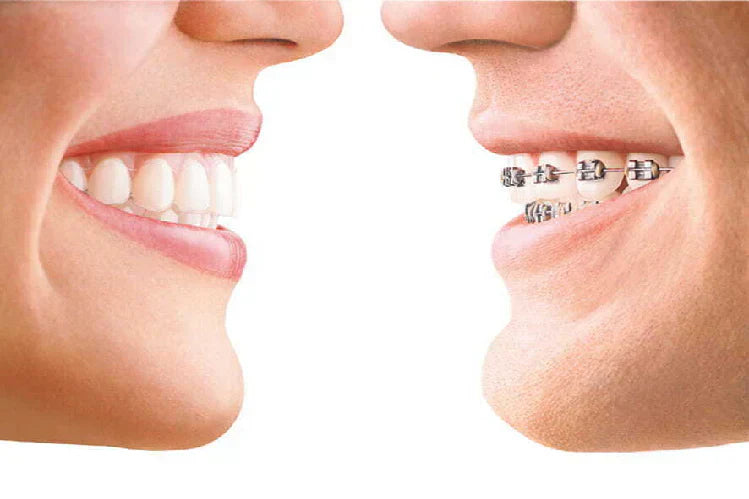
Table of Contents
- What are Braces?
- Types of Braces
- Metal Braces
- Benefits of Metal Braces
- Ceramic Braces
- Benefits of Ceramic Braces
- Lingual Braces
- Benefits of Lingual Braces
- What are Clear Aligners?
- Benefits of Clear Aligners
- Key Differences between Aligners vs Braces
- ALIGNERCO Clear Aligners
- Why Choose ALIGNERCO for Teeth Straightening?
- How Does It Work?
- Aligners or Braces: Which One Is for You?
- FAQs
Metal braces used to be the sole solution for teeth alignment, but those days are gone. With the recent advancements in the field of dentistry, teeth alignment has become easier than ever. Clear aligners for teeth have emerged as a popular alternative to braces. However, the presence of multiple teeth straightening options often makes it confusing for individuals to opt for one. In this comprehensive guide, we will provide a complete, detailed comparison between both treatment methods to help you make an informed decision.
What are Braces?
Braces are the oldest and most commonly known teeth straightening method. They are composed of brackets and wires that are fixed on the tooth surface. When it comes to the effectiveness of braces, they are used for mild, moderate, to even severe dental misalignments.
Types of Braces
The following are the different types of braces used for teeth straightening purposes. The best braces for teeth depend on your lifestyle preferences and the malocclusion you’re facing.
Metal Braces

When it comes to braces, metal braces are a common approach for teeth straightening. The metal brackets are fixed on the tooth surface with attached wires. They are well-known for treating mild, moderate, to even severe dental issues.
Benefits of Metal Braces
Effective for Complex Cases
Metal braces are the most effective solution for all types of misalignments. From mild to moderate, or even severe cases, metal braces can be the ideal solution.
Suitable for All Ages
Metal braces provide effective results for kids, teens, or even adults, regardless of age.
Durable and Long-lasting
Braces are composed of stainless steel, which makes them highly durable and resistant to damage compared to other options.
Ceramic Braces

Ceramic braces are another type of braces used for teeth straightening. They are as effective as metal braces but differ in appearance. The wires and brackets of ceramic braces are tooth colored, making them less visible. This type of braces works best for mild, moderate, or even complex cases, just like traditional braces. Individuals can also choose to get their wires and brackets colored as per their personal style.
Benefits of Ceramic Braces
Effective for Moderate to Complex Cases
Just like metal braces, ceramic braces are an effective solution for all types of misalignments, from mild to moderate, or even severe cases.
Less Noticeable
Ceramic braces are tooth-colored, which makes them less noticeable as compared to metal ones.
Lingual Braces

Lingual braces are placed on the inside of the teeth. They are similar to traditional metal braces in effectiveness. Since they are placed on the back side, they are less visible as compared to traditional ones. The wires are also hidden from view, offering a completely discreet solution.
Benefits of Lingual Braces
Not Visible
Since they are fixed on the back side of the teeth, they are not visible, making them ideal for those wanting to fix their smile without compromising their appearance.
Highly Effective
Lingual braces are highly effective even for complex orthodontic issues.
No Stains
Since lingual braces are placed on the inside, there is no risk of discoloration or white spots on the front of your teeth.
What are Clear Aligners?

The field of dentistry has revolutionized over time, offering clear aligners - a perfect alternative to traditional braces. Clear aligners are orthodontic devices that have become quite popular over time. Unlike braces, they are not fixed on the teeth but are worn on the desired tooth arch. By exerting constant pressure on the teeth, aligners help them move to a desirable position. The main feature that has made aligners popular among individuals of all ages is the invisible smile makeover and the ability to remove them for eating and maintaining oral hygiene. The usual wear time for aligners is 22 hours every day.
Benefits of Clear Aligners
Removable
Unlike metal braces,teeth aligners are not fixed to the tooth surface. They are simply worn for the prescribed time to achieve optimal results. It means you can remove your aligners whenever required.
Convenient
Since they are not attached to the teeth, aligners offer a convenient smile transformation. They are gum line trimmed and customized according to each individual’s dental structure.
Barely Visible
Aligners are composed of plastic material, which makes them barely visible. It is an ideal treatment for those who do not want to make any compromises on their appearance.
Key Differences between Aligners vs Braces
Here are the key differences between clear aligners vs braces for you to make an informed decision.
| Features | Clear Aligners | Traditional Braces |
|---|---|---|
| Appearance | Barely Visible | Visible brackets |
| Removability | Easily removable | Fixed on the teeth |
| Comfort | Less irritation | Irritation due to brackets |
| Effectiveness | Suitable for mild to moderate cases | Effective for even complex cases |
| Treatment Duration | 4 - 6 months | Typically 18 - 24 months |
ALIGNERCO Clear Aligners

When it comes to teeth straightening, ALIGNERCO offers the best solution. Our clear aligners provide a smooth makeover for individuals looking forward to getting their teeth straightened. Apart from the affordability, our clear aligners are customized to tailor to each individual’s dental requirements. You can get your teeth aligned either during the day or at night.
Why Choose ALIGNERCO for Teeth Straightening?
ALIGNERCO offers a hassle-free smile journey. However, if you are still skeptical about making a decision, the following are the reasons why you can opt for ALIGNERCOClear Aligners to get the smile of your dreams.
At-Home Treatment
The major benefit to witness while undergoing teeth straightening with ALIGNERCO is the at-home convenience. Teeth straightening usually requires frequent clinic visits for wire adjustments or dental scans. Meanwhile, with ALIGNERCO, there are no clinic visits, no long waits for dental appointments, and you can just get your treatment done from home. From impression kit to getting your custom-fit aligners, everything is delivered to your doorstep.
Invisible Makeover
ALIGNERCOClear Alignersare composed of BPA-free plastic. It means you can have your dream smile without even getting noticed. It is the ideal option for anyone who does not want their appearance compromised.
Affordable Plans
ALIGNERCO offers affordable savings of up to 40% compared to other invisible aligners and a whopping 60% from traditional braces. Our plans are customized to meet your requirements and are within your budget. Moreover, you can also find flexible payment options to make your journey even more affordable.
Expert Curated Plans
A remote treatment may make you skeptical about the results. However, at ALIGNERCO, the entire treatment plan is closely created and supervised by licensed orthodontists to guarantee optimal results.
How Does It Work?
Here is a step-by-step process on how a clear aligner treatment works at ALIGNERCO.
1. Initial Assessment
To begin your journey to a straighter smile, it is important to know if you are eligible for the treatment or not. Take a free smile assessment to know if aligners can be your right approach.
2. Choose a Plan
After reviewing your case, our experts will determine your eligibility. Pick a day or night plan that best suits your lifestyle and dental needs. On placing your order, receive our impressions kit at your doorstep.
3. Create Impressions
Once you receive our impressions kit, follow the guidelines mentioned. The kit includes all the necessary equipment required to create perfect impressions. Use them carefully and send them back to us with the help of a prepaid shipping label once you are done.
4. 3D Smile Projection
Upon receiving your impressions, our expert will create a 3D smile projection. Once you approve the smile projection, your aligners will be fabricated accordingly.
5. Aligner Journey
Receive your aligners at your doorstep and begin your journey. Individuals are advised to wear their aligners as the orthodontist prescribes to get the best results within the given time.
Aligners or Braces: Which One Is for You?
Getting the smile of your dreams has never been this easy. Both braces and aligners offer effective teeth straightening. Depending on the severity of your case, your dentist can suggest the type of treatment to you. Braces are fixed on the tooth surface with visible metal brackets. On the other hand, aligners are easily removable and are barely visible. You can opt for the option that best suits your lifestyle and case requirements. ALIGNERCOClear Alignersoffer hassle-free teeth straightening. You can get your smile fixed in no time from the comfort of your home.
FAQs
What are teeth aligners?
Teeth aligners are removable trays that are worn on the teeth to gradually straighten them. They have become a popular alternative to traditional braces.
Are aligners better than braces?
Aligners have become a popular alternative to braces due to their comfort level. Aligners are recommended for mild to moderate dental issues. On the other hand, if you are suffering from severe dental issues, braces are the recommended treatment option.
Do aligners straighten teeth faster than braces?
Yes, as compared to traditional braces, aligners offer faster teeth straightening. The usual treatment duration with clear aligners ranges between four to six months. Whereas, braces take more than a year to achieve the desired results.
How do you know if I need braces or aligners?
Your general dentist can best suggest the type of treatment according to the severity of your dental issue. If you have mild to moderate alignment issues, clear aligners could be the right approach. Whereas in the case of severe issues, you might need metal braces.
Do aligners hurt more than braces?
No, clear aligners are known for offering a comfortable smile journey. Unlike traditional braces, they do not contain metal brackets that often hurt or result in disturbing the gums. They are customized to each individual’s dental structure and are gumline trimmed for a smooth process.
What is the wear time of aligners?
Clear aligners are usually worn for 22 hours every day. Adherence to the wear time is essential to achieve your desired results.
Citations:
Baum, A. (2024, October 2). Aligners vs. Braces: A Comparison. American Association of Orthodontists. https://aaoinfo.org/whats-trending/braces-vs-clear-aligners/
Professional, C. C. M. (2024c, May 1). Teeth Braces. Cleveland Clinic. https://my.clevelandclinic.org/health/treatments/24601-teeth-braces
American Association of Orthodontists. Adult Orthodontics (https://www3.aaoinfo.org/wp-content/uploads/2018/07/Adult_Orthodontics15-cons-hl-1.pdf). Accessed 1/13/2023.
American Dental Association. Braces (https://www.mouthhealthy.org/all-topics-a-z/braces). Accessed 1/13/2023.
American Dental Association. Chewing Gum (https://www.ada.org/resources/research/science-and-research-institute/oral-health-topics/chewing-gum). Accessed 1/13/2023.
Lin E, Julien K, Kesterke M, Buschang PH. Differences in finished case quality between Invisalign and traditional fixed appliances (https://pubmed.ncbi.nlm.nih.gov/35168256/). Angle Orthod. 2022 Mar 1;92(2):173-179. Accessed 1/13/2023.
Turner S, Harrison JE, Sharif FN, Owens D, Millett DT. Orthodontic treatment for crowded teeth in children (https://pubmed.ncbi.nlm.nih.gov/34970995/). Cochrane Database Syst Rev. 2021 Dec 31;12(12): CD003453. Accessed 1/13/2023.
American Association of Orthodontists. Adult Orthodontics (https://www3.aaoinfo.org/wp-content/uploads/2018/07/Adult_Orthodontics15-cons-hl-1.pdf). Accessed 1/13/2023.
American Dental Association. Braces (https://www.mouthhealthy.org/all-topics-a-z/braces). Accessed 1/13/2023.
Professional, C. C. M. (2024, May 1). Clear braces. Cleveland Clinic. https://my.clevelandclinic.org/health/treatments/23568-clear-braces
Weir, T. (2017b). Clear aligners in orthodontic treatment. Australian Dental Journal,






